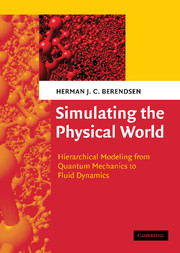Book contents
- Frontmatter
- Contents
- Preface
- Symbols, units and constants
- Part I A Modeling Hierarchy for Simulations
- Part II Physical and Theoretical Concepts
- 12 Fourier transforms
- 13 Electromagnetism
- 14 Vectors, operators and vector spaces
- 15 Lagrangian and Hamiltonian mechanics
- 16 Review of thermodynamics
- 17 Review of statistical mechanics
- 18 Linear response theory
- 19 Splines for everything
- References
- Index
17 - Review of statistical mechanics
Published online by Cambridge University Press: 05 June 2012
- Frontmatter
- Contents
- Preface
- Symbols, units and constants
- Part I A Modeling Hierarchy for Simulations
- Part II Physical and Theoretical Concepts
- 12 Fourier transforms
- 13 Electromagnetism
- 14 Vectors, operators and vector spaces
- 15 Lagrangian and Hamiltonian mechanics
- 16 Review of thermodynamics
- 17 Review of statistical mechanics
- 18 Linear response theory
- 19 Splines for everything
- References
- Index
Summary
Introduction
Equilibrium statistical mechanics was developed shortly after the introduction of thermodynamic entropy by Clausius, with Boltzmann and Gibbs as the main innovators near the end of the nineteenth century. The concepts of atoms and molecules already existed but there was no notion of quantum theory. The link to thermodynamics was properly made, including the interpretation of entropy in terms of probability distributions over ensembles of particle configurations, but the quantitative counting of the number of possibilities required an unknown elementary volume in phase space that could only later be identified with Planck's constant h. The indistinguishability of particles of the same kind, which had to be introduced in order to avoid the Gibbs' paradox, got a firm logical basis only after the invention of quantum theory. The observed distribution of black-body radiation could not be explained by statistical mechanics of the time; discrepancies of this kind have been catalysts for the development of quantum mechanics in the beginning of the twentieth century. Finally, only after the completion of basic quantum mechanics around 1930 could quantum statistical mechanics – in principle – make the proper link between microscopic properties at the atomic level and macroscopic thermodynamics. The classical statistical mechanics of Gibbs is an approximation to quantum statistics.
In this review we shall reverse history and start with quantum statistics, proceeding to classical statistical mechanics as an approximation to quantum statistics. This will enable us to see the limitations of classical computational approaches and develop appropriate quantum corrections where necessary.
- Type
- Chapter
- Information
- Simulating the Physical WorldHierarchical Modeling from Quantum Mechanics to Fluid Dynamics, pp. 453 - 504Publisher: Cambridge University PressPrint publication year: 2007



